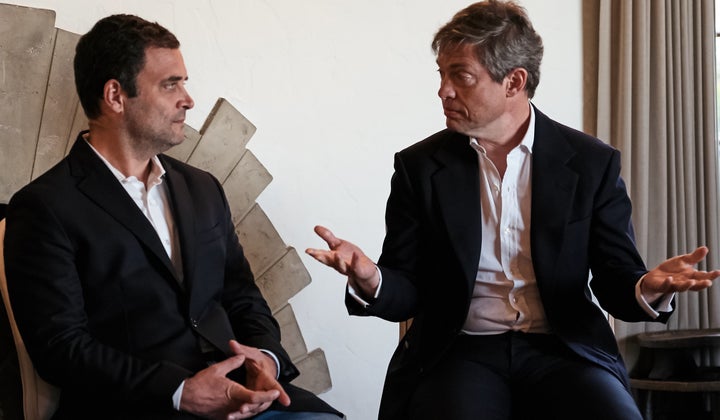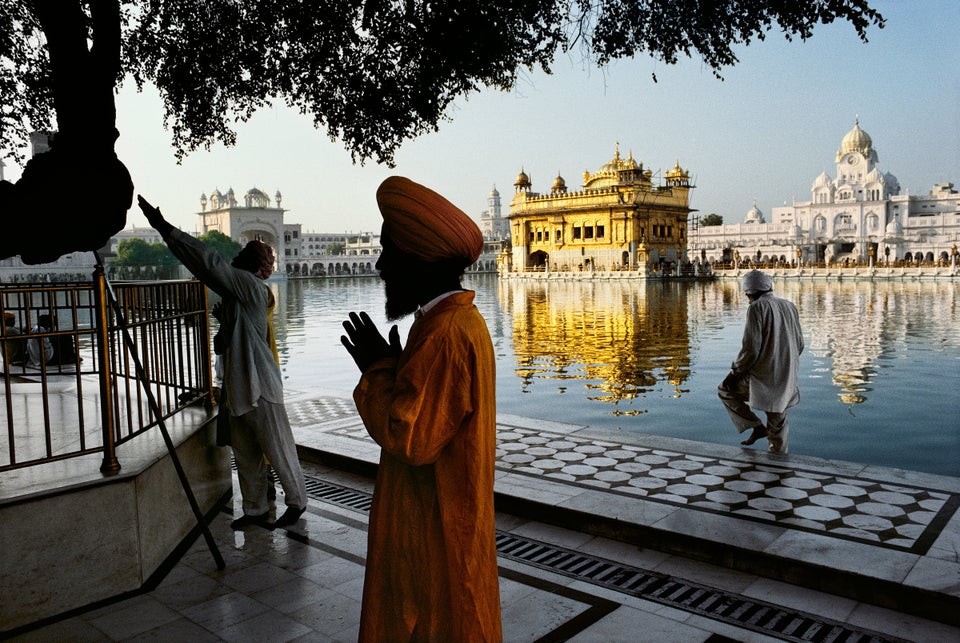
Rahul Gandhi is the vice president of India’s opposition Congress Party and heir to the Nehru-Gandhi political dynasty. Both his grandmother, Indira Gandhi, and his father, Rajiv Gandhi, were prime ministers. He is the great-grandson of India’s first prime minister, Jawaharlal Nehru.
During his recent visit to the United States, Gandhi sat down for a conversation with Nicolas Berggruen, chairman of the Berggruen Institute and publisher of The WorldPost. They discussed India’s challenges of internal migration, Hindu nationalist politics and the rising power of China in Asia.
India is the largest democracy in the world, and democracies across the world ― including the United States ― are facing many challenges, notably the divisive forces of nationalism and populism. How is India faring?
The central difference between the United States and India’s system is that India is composed of 29 states with completely different cultures and languages. In that sense, our diversity is more like Europe’s. If you look at states like Tamil Nadu [in the south] and Mizoram [in the northeast], the differences between them are greater than between any two countries in Europe.
“'Economic insecurity about finding work and anxieties over identity are being aggressively exploited by India's right-wing.'”
The other thing to understand about India is that, like China, it is undergoing the greatest migration in human history from rural areas to megacities. In the Chinese system, that mass movement is controlled. In India, people from all our different cultures, languages and religions are able to move freely to any city in the country to look for jobs. If they don’t find work in one city, they simply move on to another one.
So, if you are thinking about development and identity, you can’t think about it in the old way. The challenge now is how to create jobs for people in the cities and support agriculture in the rural areas. We’ve gone from a static idea of development to a dynamic one. We have to protect and support our people as they move from the village to the city and back. Ideas like our universal ID guaranteed work scheme and Right to Information Act are designed for this new environment.
All the stresses of modernity and migration affect the present tone of politics in India. Economic insecurity about finding work and anxieties over identity are being aggressively exploited by the right-wing. They spread fake news, promote ethnic rifts and foment polarization in order to gain power across states. They divide communities using hatred and turn them against each other to come to power.
Access to communications, including social media, has many wonderful aspects. But when the editors, so to speak, lose control and people spread false or hateful information by sharing it directly with their peers, it can be highly damaging, as you suggest. Whoever speaks loudest or has the most viral message wins out. That makes democracy harder. How does this play out in India?
We are seeing the same impact that you see in the United States, with citizens able to connect with each other and communicate directly with political leaders. In a sense, this disintermediation is the democratization of information. And the pace has accelerated, from a news cycle when newspaper journalists had time to do their homework to a controversy erupting every five minutes on social media. That is a real challenge to democracy.
“'Hatred is the BJP's main weapon. They are creating massive fault lines by isolating millions of our people.'”
In India, we see political organizations like the BJP [the ruling Bharatiya Janata Party] and its umbrella organizations like the RSS [the right-wing Hindu nationalist Rashtriya Swayamsevak Sangh] moving in to directly manipulate that space. Hatred is their main weapon. They are creating massive fault lines by isolating millions of our people. Tribals, Dalits and Muslims are simply being told by the ruling party that they cannot be part of India’s vision. Journalists are being shot dead.
How do you run a democratic country, especially one as diverse as India, in this environment?
The main problem in India is overconcentration of power. Almost all important decisions in India today are taken at the prime minister’s level. And at the state level, they’re taken by the chief minister.
Meanwhile, the parliament in India is currently being reduced to a debating society without any power. While members of parliament talk to each other, the executive and the bureaucracy actually run the country. The only way to right India’s problems is to push power out through more democratization and decentralization.
China has been very successful in lifting hundreds of millions out of poverty and modernizing its infrastructure ― including all those bullet trains. Yet it is a highly centralized state with power concentrated in the Communist Party at the top. Maybe more power at the top to push through policies that might be blocked locally is not a bad idea for India?
Actually, I would argue that India today is more centralized than China. The Communist Party centralizes certain aspects. But if you look at Chinese cities, local governments have a lot of power. Even if one was to follow your argument and centralize India even more, the type of reaction you would get ― and it is already coming ― would be very dangerous.
“'Economic progress in a diverse and dynamic country like India can’t be fulfilled through exclusion.'”
The centralization of power tends to be exclusionary and doesn’t allow the voices of many to be heard. Economic progress in a diverse and dynamic country like India can’t be fulfilled through exclusion; rather, inclusion is absolutely necessary for progress.
Decentralization and politically embracing people and communities has worked in India. Let me give you an interesting and extreme example. In the state of Mizoram in the 1980s, a full-blown insurgency was taking place. The government went to the insurgents and said: “Why don’t you get involved in running the state? Are you ready? Are you capable? If so, there are two conditions: First, put down your weapons. Second, follow the Indian constitution.” They accepted. The entire state government resigned and a party formed by former insurgents took over. The leader of the insurgency became the chief minister of the state; they [the new party] ran Mizoram for the next several years and have taken part in elections ever since then. The state is calm and stable now.
That is how India successfully fought insurgencies ― not by stamping them down and trying to crush them, but by pushing power out and bringing people inclusively into the democratic system.
Of course, I’m not saying this is how to resolve all conflicts. But I am saying that the principle of decentralization of power and embracing people is a powerful way of making India work effectively.
In recent decades, democracy has been able to transform itself in India without the kind of mass violence, famine and dislocation that we saw in China during the Great Leap Forward and the Cultural Revolution. Is the kind of openness you described still the case in India going forward even with a less tolerant, hardening regime charting a more authoritarian path?
Some years ago when I was on an official trip to Singapore, someone asked: “China is growing at 11 percent per year; India at 9 percent. Wouldn’t India do better if it adopted the Chinese route to development?” I told them they were asking the wrong person.
China has paid a huge price for what it has achieved. Thirty million people died in China as a result of its policies over the years. I am very proud that my country has done nearly what China has without sacrificing millions of people. I am more than happy to give up one or two percentage points in GDP growth for the lives of 30 million people.
“'I am very proud that my country has done nearly what China has without sacrificing millions of people.'”
With respect to the hardening taking place in India, there are two basic issues that underlay the turn in Indian politics today. The real challenge for India is to find jobs for millions and millions of its youngsters. Thirty thousand Indian people come into the job market every single day, but only 500 people a day actually get any jobs. That is a huge discrepancy. [Prime Minister Narendra] Modi came to power by promising jobs, and his record so far has been disastrous. His administration is taking the anger of the youth and diverting it against minorities. That is what most right-wing leaders do ― this bait-and-switch is not dissimilar from what the right-wing are doing all over the world.
With their system of controlled population, cheap labor and manufacturing for export, the Chinese have basically cornered the blue-collar job market globally. The real challenge for India is how to compete with China for jobs while maintaining a democratic environment.
The second issue is that with advent of the internet and communication technology, institutions no longer have dominance over their space.
What defines an institution? Its monopoly over information. But that’s gone now. In all cases, whether we are talking about the realm of professionals, the traditional media or even the judicial system or the police ― no one has monopoly over information any longer. Democracies today exist in a world of institutional confrontation.
This combination of joblessness along with institutional civil war ― which is happening in India, in America, in Europe ― is a true crisis for all democratic societies. It is this combination of circumstances that has created the space for leaders like Modi and [Philippine President Rodrigo] Duterte who thrive on hatred and disrespect institutions.
“'Modi's administration is taking the anger of the youth and diverting it against minorities.'”
Demonetization of 86 percent of our currency, a decision taken unilaterally by Prime Minister Modi last November, is a superb example of this type of leadership. Demonetization was a body blow to our economy and wiped out more than 2 percent of GDP. It sent a shockwave through the informal economy and wiped out more than 1 million jobs. The PM ignored our economic and financial institutions and took this decision personally. The previous central bank governor has publicly stated that he advised the government against demonetization. Even the economic adviser to the government was not consulted. This has damaged India very badly.
Speaking of China, how do you see its new Silk Road initiative, which is building out infrastructure across Eurasia to Europe and Africa?
It is a very powerful policy from their perspective. It is an attempt at redesigning the world. I don’t see a clear response to it, however, and I am not one of those that underestimates their capability to pull it off.
“'Modi is a status-quoist pretending to be a reformer.'”
The caste system has been one of the historical features of Indian society. From the beginning, the Congress Party has aimed to demolish that system. Yet, some now say that Modi is in reality doing so with his meritocratic approach to governance. What is your view on that?
No. That is simply not true. The central fight between the BJP and the Congress Party is about caste. The Congress Party brought the idea of one man, one vote to India. That idea is inimical to the caste tradition. The only way to weaken the caste system is to strengthen the vote. You don’t strengthen the vote by destroying institutions but by empowering the democratic process.
I would argue that Modi is actually strengthening and defending India’s caste structure. That is his entire design. Modi has followed the model of the Muslim Brotherhood [in Egypt] to use democracy to come to power. He has filled our institutions with people who propagate a certain divisive ideology and is now imposing a vision of India that excludes India’s Dalits, tribals and minorities. He is a status-quoist pretending to be a reformer.
This interview was edited, condensed and adapted for clarity.

